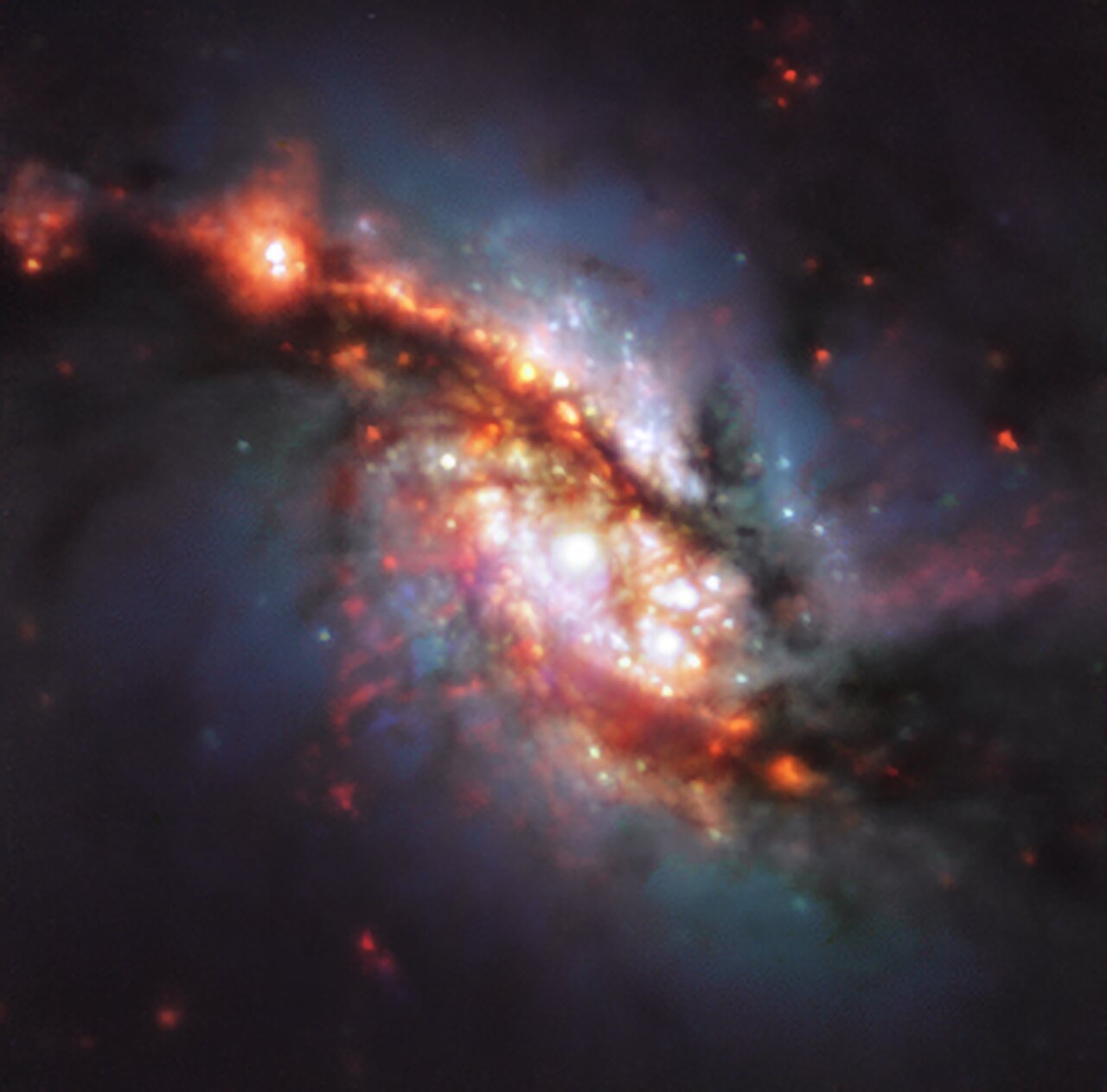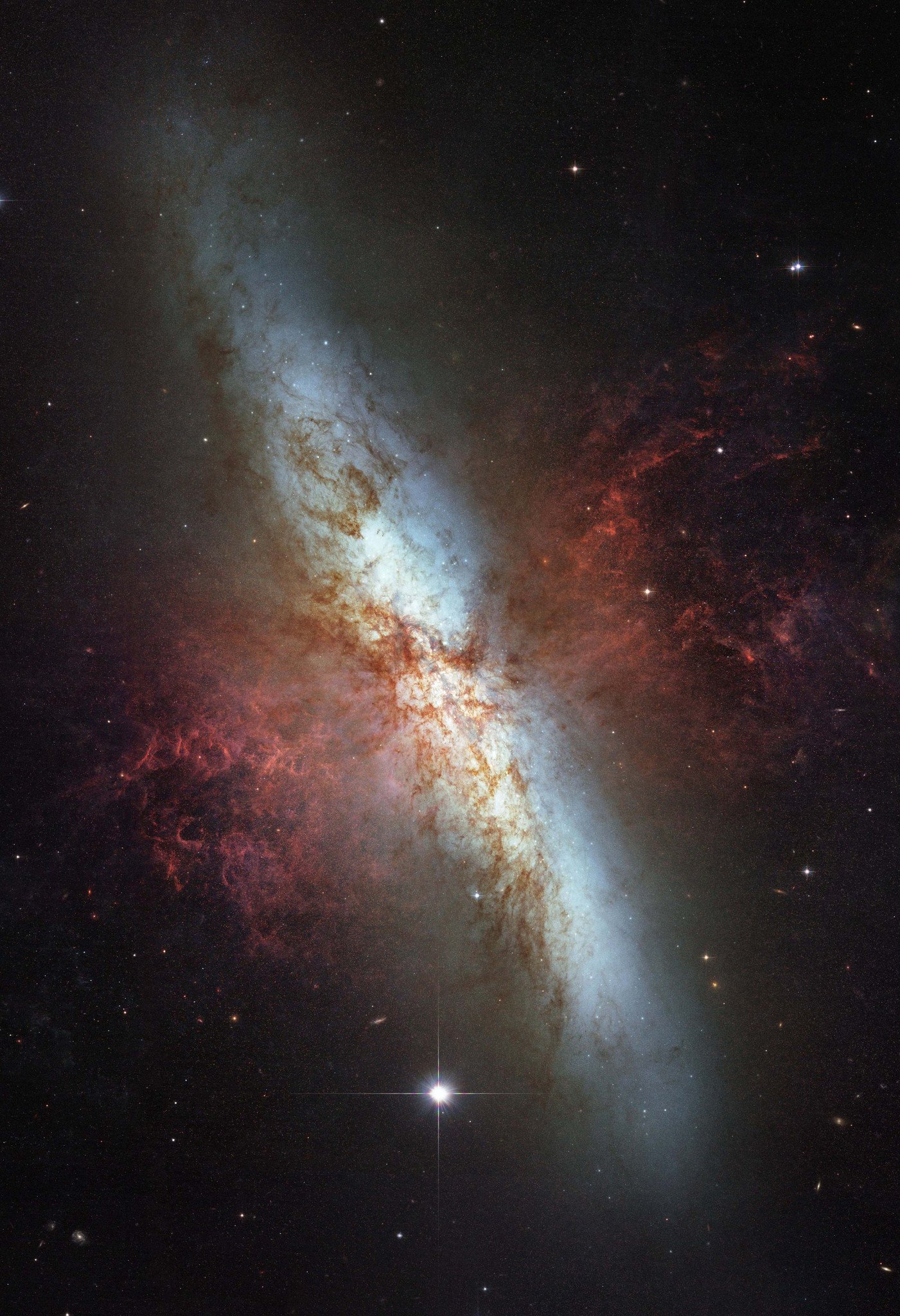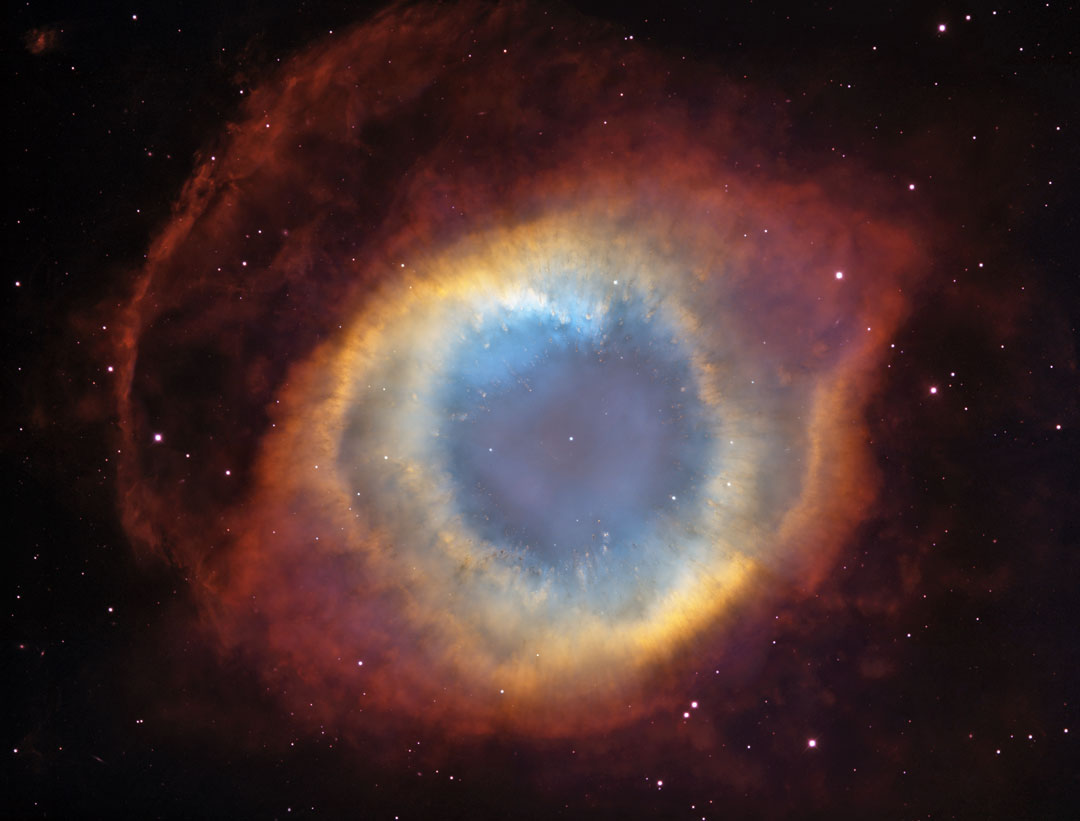Blog
The MUSE instrument on ESO’s Very Large Telescope (VLT) in Chile has observed NGC 1365, a double-barred spiral galaxy located about 56 million light-years away in the Fornax galaxy cluster, allowing us to construct this spectacular colour image. The galaxy is also known as the Great Barred Spiral Galaxy, after its two central bar-shaped structures, made up of stars.
The two bars of NGC 1365 are a rare phenomenon and are thought to have originated by the combined effects of galaxy rotation and the complex dynamics of the stars. Its largest bar of stars, too large for its structure to be visible in this image, connects its outer spiral arms to its centre. What we can see is the much smaller second bar of stars, nestled within the main bar. It is likely this secondary bar acts independently of the main bar, rotating more rapidly than the rest of the galaxy.
Standing for Multi-Unit Spectroscopic Explorer, the MUSE instrument captured this image in optical and infrared light, showing the gas and dust in the central region of the galaxy. Installed on Yepun, one of the four 8.2-metre telescopes that make up the VLT, the capabilities of this instrument have allowed for some of the most comprehensive and detailed studies of our Universe to date, including surveys of distant galaxies, supermassive black holes and even the source of gravitational waves.

Declan Patrick MacManus, OBE (born 25 August 1954), known professionally as Elvis Costello, is an English singer-songwriter. He has won multiple awards in his career, including Grammy Awards in 1999 and 2020, and has twice been nominated for the Brit Award for Best British Male Artist. In 2003, he was inducted into the Rock and Roll Hall of Fame. In 2004, Rolling Stone ranked Costello number 80 on its list of the 100 Greatest Artists of All Time.
Costello began his career as part of London’s pub rock scene in the early 1970s and later became associated with the first wave of the British punk and new wave movement that emerged in the mid-to-late 1970s. His critically acclaimed debut album My Aim Is True was released in 1977. Shortly after recording it, he formed the Attractions as his backing band. His second album This Year’s Model was released in 1978, and was ranked number 11 by Rolling Stone on its list of the best albums from 1967 to 1987. His third album Armed Forces was released in 1979, and features his highest-charting single, “Oliver’s Army” (number 2 in the UK). His first three albums all appeared on Rolling Stone‘s list of the 500 Greatest Albums of All Time.
Costello and the Attractions toured and recorded together for the better part of a decade, though differences between them caused a split by 1986. Much of Costello’s work since has been as a solo artist, though reunions with members of the Attractions have been credited to the group over the years. Costello’s lyrics employ a wide vocabulary and frequent wordplay. His music has drawn on many diverse genres; one critic described him as a “pop encyclopaedia”, able to “reinvent the past in his own image”.
Costello has co-written several original songs for motion pictures, including “God Give Me Strength” from Grace of My Heart (1996, with Burt Bacharach) and “The Scarlet Tide” from Cold Mountain (2003, with T-Bone Burnett). For the latter, Elvis was nominated (along with Burnett) for the Academy Award for Best Original Song and the Grammy Award for Best Song Written for Visual Media.
more...Charles Fambrough (August 25, 1950 – January 1, 2011) was an American jazz bassist, composer and record producer from Philadelphia. Fambrough was a member of Art Blakey’s Jazz Messengers during the early 1980s.
more...
Pat Martino (born August 25, 1944) is an American jazz guitarist and composer. Martino was born Pat Azzara in South Philadelphia. He began playing professionally at the age of 15 after moving to New York City. He lived for a period with Les Paul and began playing at jazz clubs such as Smalls Paradise. He later moved into a suite in the President Hotel on 48th Street. He would play at Smalls for six months of the year, and then in the summer play at the Club Harlem in Atlantic City.
Martino played and recorded early in his career with Lloyd Price, Willis Jackson, and Eric Kloss. He also worked with jazz organists Charles Earland, Richard “Groove” Holmes, Jack McDuff, Don Patterson, Trudy Pitts, Jimmy Smith, Gene Ludwig, and Joey DeFrancesco.
Martino had been performing until an aneurysm in 1980 left him with amnesia and no recollection or knowledge of his career or how to play the very instrument that made him successful. Martino says he came out of surgery with complete forgetfulness, learning to focus on the present instead of the past or what may lie ahead. He was forced to learn how to play the guitar from zero. This circumstance is crucial to understand his career and his particular way of thinking.
Martino is married to Ayako Asahi Martino, whom he met in Tokyo, Japan, in 1995.
more...Wayne Shorter (born August 25, 1933) is an American jazz saxophonist and composer. Shorter came to wide prominence in the late 1950s as a member of, and eventually primary composer for Art Blakey‘s Jazz Messengers. In the 1960s, he went on to join Miles Davis‘s Second Great Quintet, and from there he co-founded the jazz fusion band Weather Report. He has recorded over 20 albums as a bandleader.
Many of Shorter’s compositions have become jazz standards, and his output has earned worldwide recognition, critical praise and various commendations. Shorter has won 11 Grammy Awards. He has also received acclaim for his mastery of the soprano saxophone (after switching his focus from the tenor in the late 1960s), beginning an extended reign in 1970 as Down Beat‘s annual poll-winner on that instrument, winning the critics’ poll for 10 consecutive years and the readers’ for 18. The New York Times described Shorter in 2008 as “probably jazz’s greatest living small-group composer and a contender for greatest living improviser.” In 2017, he was awarded the Polar Music Prize.
Wayne Shorter was born in Newark, New Jersey, United States, and attended Newark Arts High School, from which he graduated in 1952. He loved music, being encouraged by his father to take up the clarinet as a teenager; his older brother Alan played alto saxophone before switching to the trumpet in college. While in high school Wayne also performed with the Nat Phipps Band in Newark, NJ. After graduating from New York Universitywith a degree in music education in 1956, Shorter spent two years in the U.S. Army, during which time he played briefly with Horace Silver. After his discharge, he played with Maynard Ferguson. In his youth Shorter had acquired the nickname “Mr. Gone”, which later became an album title for Weather Report.
more...Messier 82 (also known as NGC 3034, Cigar Galaxy or M82) is a starburst galaxy approximately 12 million light-years away in the constellationUrsa Major. A member of the M81 Group, it is about five times more luminous than the whole Milky Way and has a center one hundred times more luminous than our galaxy’s center. The starburst activity is thought to have been triggered by interaction with neighboring galaxy M81. As the closest starburst galaxy to Earth, M82 is the prototypical example of this galaxy type. SN 2014J, a type Ia supernova, was discovered in the galaxy on 21 January 2014. In 2014, in studying M82, scientists discovered the brightest pulsar yet known, designated M82 X-2.

Oteil Burbridge August 24, 1964 (age 56 years), Washington, D.C. is an American multi-instrumentalist, specializing on the bass guitar, trained in playing jazz and classical music from an early age. He has achieved fame primarily on bass guitar during the resurgence of the Allman Brothers Band from 1997 through 2014, and as a founding member of the band Dead & Company. Burbridge was also a founding member of The Aquarium Rescue Unit, and has worked with other musicians including Bruce Hampton, Trey Anastasio, Page McConnell, Bill Kreutzmann and The Derek Trucks Band, with whom his brother Kofi Burbridge was the keyboardist and flautist.
Burbridge has been recognized for his ability to incorporate scat-singing into his improvised bass solos. Burbridge endorses Fodera, Modulus, Sukop and Dunlop guitars and effects.
more...David Freiberg (pronounced FRY-BERG) (born August 24, 1938 Boston) is an American musician best known for contributing vocals, keyboards, electric bass, rhythm guitar, viola and percussion as a member of Quicksilver Messenger Service, Jefferson Airplane and Jefferson Starship. Among other tracks, he co-wrote “Jane,” a hit for Jefferson Starship.
John Cipollina (August 24, 1943 – May 29, 1989 Berkeley, CA) was a guitarist best known for his role as a founder and the lead guitarist of the prominent San Francisco rock band Quicksilver Messenger Service. After leaving Quicksilver he formed the band Copperhead, was a member of the San Francisco All Stars and later played with numerous other bands.
more...Henry Franklin “Buster“ Smith (August 24, 1904 – August 10, 1991), also known as Professor Smith, was an American jazz alto saxophonist and mentor to Charlie Parker. Smith was instrumental in instituting the Texas Sax Sound with Count Basie and Lester Young in the 1930s.
Smith played saxophone for a number of prominent band leaders including Duke Ellington and Earl Hines as well as vocalist Ella Fitzgerald. He recorded his only album as leader in 1959 and despite intending to record a follow-up, he was injured in an accident and nothing else was released.
Smith was born and raised in Alsdorf, Texas, a small township near Telico in the outskirts of Dallas, where he attended school as a child. Smith earned the name “Buster” from his parents as a baby, as he was born as an overweight child. Buster was the third of five boys and had no sisters, though both of his older brothers died in childhood of measles.
Smith’s early musical influences were his mother, and his father, who played guitar. At the age of four years, Buster was playing the organ with his brother, pianist Boston Smith; Buster played the keys and Boston stepped on the pedals. Soon thereafter, his grandfather gave away the family organ because he believed it would only direct Buster to a life of sin.
more...Arthur William “Big Boy” Crudup (August 24, 1905 – March 28, 1974) was an American Delta blues singer, songwriter and guitarist. He is best known, outside blues circles, for his songs “That’s All Right” (1946), “My Baby Left Me” and “So Glad You’re Mine”, later recorded by Elvis Presleyand other artists.
Crudup was born in Forest, Mississippi, to a family of migrant workers traveling through the South and Midwest. The family returned to Mississippi in 1926, where he sang gospel music. He had lessons with a local bluesman, whose name was Papa Harvey, and later he was able to play in dance halls and cafes around Forest. Around 1940 he went to Chicago.
more...The shapes of planetary nebula like the Helix are important because they likely hold clues to how stars like the Sun end their lives. Observations by the orbiting Hubble Space Telescope and the 4-meter Blanco Telescope in Chile, however, have shown the Helix is not really a simple helix. Rather, it incorporates two nearly perpendicular disks as well as arcs, shocks, and even features not well understood. Even so, many strikingly geometric symmetries remain. How a single Sun-like star created such beautiful yet geometric complexity is a topic of research. The Helix Nebula is the nearest planetary nebulato Earth, lies only about 700 light years away toward the constellation of Aquarius, and spans about 3 light-years.

More Posts
- Daily Roots with Alton Ellis & the Heptones
- The Cosmos with Sharpless 2-106
- John Medeski Day
- David Honeyboy Edwards Day
- World Music with Odpoczno
- Daily Roots with Ras Tweed
- The Cosmos with M8
- Johnny “Big Moose” Walker Day
- Elmo Hope Day
- Shad Collins Day
- World Music with Eleftheria Arvanitaki
- Daily Roots with Israel Vibration
- The Cosmos with NGC 1187
- Reggie Workman Day
- Big Bill Broonzy Day
- World Music with Very Be Careful
- Daily Roots with Uwe Banton
- The Cosmos with M20
- Joe Chambers Day
- Clifton Chenier Day